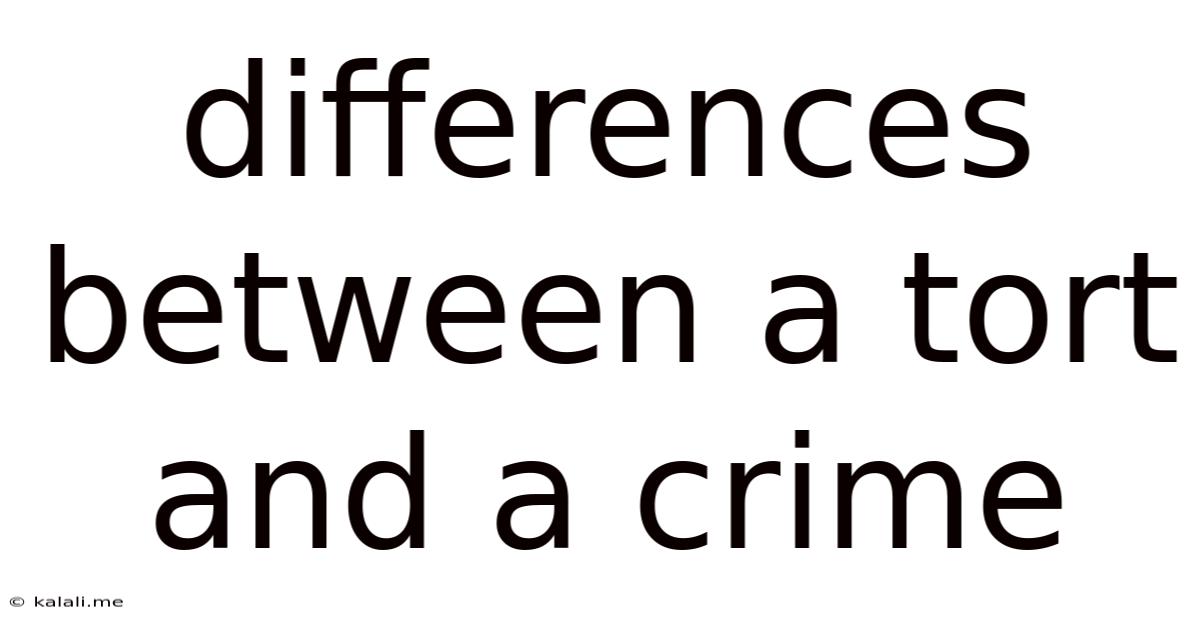Differences Between A Tort And A Crime
Kalali
Jun 12, 2025 · 3 min read

Table of Contents
The Key Differences Between a Tort and a Crime
Understanding the difference between a tort and a crime is crucial, particularly if you're involved in a legal dispute. While both involve wrongdoing, they differ significantly in their nature, purpose, and consequences. This article will illuminate the key distinctions between these two legal concepts, helping you grasp the nuances of civil and criminal law.
What is a Tort?
A tort is a civil wrong that causes someone harm. It's a breach of a legal duty owed to another person, resulting in injury or damage. The focus in tort law is on compensating the victim for their losses. Think of it as a private wrong—one individual or entity suing another for damages. Examples include negligence (causing harm through carelessness), defamation (damaging someone's reputation), trespass (unlawful entry onto someone's property), and assault and battery (physical harm or threat of harm). The victim initiates the lawsuit, and the burden of proof lies on them to demonstrate the defendant's wrongdoing. Successful cases usually result in monetary compensation (damages) for the plaintiff.
What is a Crime?
A crime, on the other hand, is a public wrong—an act that violates a statute and is considered harmful to society as a whole. Crimes are prosecuted by the state (government), not by private individuals. The goal of criminal law is to punish the offender and deter future criminal behavior. Examples include theft, murder, assault, fraud, and drug trafficking. The state bears the burden of proof, needing to demonstrate the defendant's guilt "beyond a reasonable doubt." Successful prosecutions can lead to a wide range of penalties, from fines and probation to imprisonment and even the death penalty.
Key Differences Summarized:
Here's a table summarizing the core differences between torts and crimes:
| Feature | Tort | Crime |
|---|---|---|
| Nature | Civil wrong | Public wrong |
| Initiator | Private individual (plaintiff) | State (government) |
| Goal | Compensation of victim | Punishment of offender, deterrence |
| Burden of Proof | Plaintiff (preponderance of evidence) | State ("beyond a reasonable doubt") |
| Outcome | Monetary damages, injunctions | Fines, imprisonment, probation, death penalty |
| Examples | Negligence, defamation, trespass | Murder, theft, assault, drug trafficking |
Overlapping Cases:
It's important to note that a single act can sometimes be both a tort and a crime. For instance, if someone assaults another person, the victim can sue the assailant for damages in a civil court (tort) and the state can prosecute the assailant for assault in a criminal court (crime). These cases would proceed separately, with different standards of proof and potential outcomes.
Understanding the Legal Landscape:
This distinction is critical for understanding the legal landscape. Civil and criminal courts operate under separate rules and procedures. While a criminal conviction might influence a civil case, the two proceedings are fundamentally distinct.
In conclusion, the key differences lie in the nature of the wrong (private vs. public), the goal of the legal action (compensation vs. punishment), and the parties involved (individual vs. state). Understanding these distinctions is vital for navigating the complexities of the legal system.
Latest Posts
Latest Posts
-
How Many Pounds Is A Bushel Of Peanuts
Jul 01, 2025
-
How Many Pounds Are In 32 Ounces
Jul 01, 2025
-
What Year Would I Be Born If I Was 21
Jul 01, 2025
-
How Many Minutes Are In 40 Hours
Jul 01, 2025
-
How Many Cups Are In 16 Oz Of Sour Cream
Jul 01, 2025
Related Post
Thank you for visiting our website which covers about Differences Between A Tort And A Crime . We hope the information provided has been useful to you. Feel free to contact us if you have any questions or need further assistance. See you next time and don't miss to bookmark.